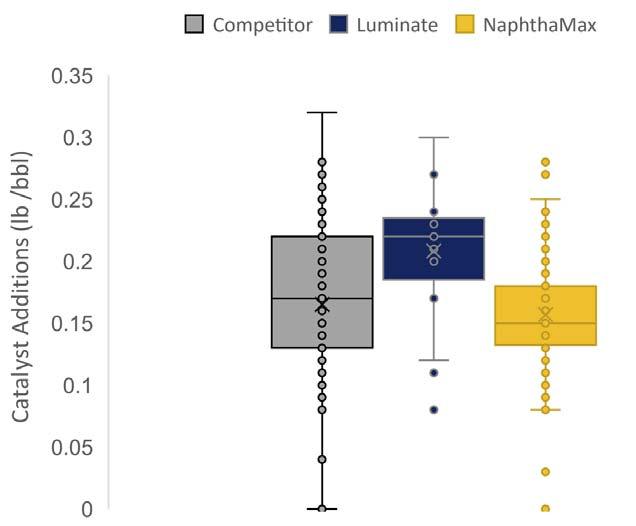
15 minute read
An evergreen optimisation approach


A. Chen, A. Novotny, T. Case, D. Banks, and B. Eren, BASF, USA, outline how FCC catalysts optimise bottoms cracking.

Fluidised catalytic cracking (FCC) unit bottoms are often one of the lowest value refi nery products, and thus good bottoms cracking performance is desired by many refi ners. This desire is evident in that bottoms cracking is consistently one of the most requested objectives for catalyst selection studies. Bottoms yields are typically set by refi nery crude selection, market economics, and unit limits, which are all often outside of FCC unit control. The choice of FCC catalyst strongly infl uences bottoms cracking performance, and is therefore a cost-effective and practical solution to optimising
FCC bottoms yields. This article discusses the main considerations that infl uence bottoms cracking, and then presents case studies demonstrating the value of good catalyst design strategy for minimising bottoms yield. Recently, there has been intense focus on developing catalytic materials to minimise bottoms yields, but it can often seem mysterious how those novel materials are utilised to improve refi nery profi tability. A sound catalyst design must factor how catalytic materials interact with complex refi nery objectives and constraints to unlock profi tability. In fact, the meaning of ‘bottoms cracking’ may be dependent on unit circumstances (e.g. minimum bottoms vs heavier bottoms) and sometimes may not even address bottoms yield directly (e.g. increased light cycle oil [LCO], minimum coke, or heavier feed). Improving bottoms cracking does sometimes require using novel matrix materials; however, it is often straightforward to enable bottoms cracking simply by adjusting LPG/naphtha ratio to enable higher conversion. The following sections of this article cover key factors which infl uence bottoms yields and the value of bottoms conversion.

Feed and catalyst impacts on bottoms yield, bottoms quality, and coke
It is well understood that FCC feed quality represents the single largest contribution to conversion and raw product quality. In general, a lighter feed (high API) tends to be more crackable than a heavier, resid-based feed. Higher-boiling range materials in resid feeds have greater concentrations of aromatics and are thus more diffi cult to crack in an FCC unit. In addition to measuring bulk properties, it is important to understand feed sources since feeds which appear similar based on bulk properties can exhibit quite different crackability. For example, due to its high aromaticity, coker gasoil produces lower conversion and less valuable yield slate compared to vacuum gasoil (VGO) than would be expected by examining bulk properties. Feed metals and nitrogen content also have a profound infl uence on bottoms upgrading improvement, by directly inhibiting the FCC catalyst’s performance and impacting yields. By far, the most impactful feed metals are sodium and vanadium, which irreparably destroy the catalyst’s crystalline structure, leading to reduced activity, lower conversion, and poorer coke selectivity. The strong dehydrogenation activity of nickel and copper deposits on catalyst directly increase FCC dry

gas yield. Iron can also be troublesome for some catalysts, as it blocks surface pores, thereby preventing access to interior active surface area. In terms of catalyst design, the elements which hold greatest infl uence over bottoms upgrading capability are matrix activity and rare earth content. Specifi cally, catalyst suppliers consider zeolite-to-matrix (Z/M) and rare-earth-to-zeolite (REO/Z) ratios when designing a catalyst formulation for improved bottoms upgrading performance.
Matrix activity plays a prominent role in a catalyst’s bottoms upgrading capability by increasing LCO/bottoms vs coke. Typically, the lower a catalyst’s Z/M, the greater the extent of bottoms upgrading which can be expected for a given catalyst activity and conversion. Moreover, the type and relative quantity of matrix employed will impact bottoms upgrading, as well as coke and yield selectivities. A common trade-off for improved LCO/bottoms is reduced activity retention. Since LCO/bottoms typically improves with increased activity, the Z/M vs activity relationship must be carefully considered when designing a catalyst for optimal bottoms upgrading.
Increasing rare earth content will increase activity, thereby increasing conversion and bottoms upgrading capability. However, the resulting increase in the catalyst’s REO/Z ratio will tend to impart a higher gasoline selectivity and reduced gasoline octane, along with lower LPG olefi n selectivity. Having an awareness of these trade-offs enables the refi ner and catalyst supplier to move a unit around its optimisation space to fully optimse bottoms upgrading performance.
Impacts of FCC constraints
Now that this article has touched on feed and catalyst factors which infl uence bottoms yield, it will focus on how unit constraints infl uence how a refi ner may view and approach bottoms upgrading. Often, unit constraints dictate bottoms cracking limits, and understanding constraints determines what bottoms cracking means to that unit and what can be done to achieve the objective. While feed quality is not typically adjustable, catalyst can be tailored to produce optimal yields with a unit’s constraints. This section walks through ideas for addressing some common constraints.
The most common constraints encountered on an FCC relate to key rotating equipment, such as the main air blower and wet gas compressor. Constraints on both pieces of rotating equipment limit conversion, and thus limit bottoms cracking. An FCC facing a wet gas compressor constraint could limit the reactor temperature, thereby reducing the fl exibility to increase conversion. An FCC facing a main air blower constraint could be limited on the minimum feed preheat temperature and maximum reactor temperature. Thus, consideration of REO/Z and Z/M ratios is important to optimise catalyst activity in order to maximise conversion within the reactor temperature and catalyst to oil limitations set by these pieces of equipment.
Additionally, the ability to reduce bottoms may be hindered by metals contamination from heavier feedstocks. The tendency of a feed (e.g. concarbon, metals) to produce high delta coke often leads to high regenerator temperatures and results in similar limits on conversion. High contaminant metals could lead to excessive coke and dry gas yields, limiting both the main air blower and the wet gas compressor or resulting in a fuel gas processing limitation. Increased contaminant metals could also push a unit to its catalyst addition limit to maintain a target catalyst activity. Thus, catalyst design must take metals trapping and passivation into consideration along with the zeolite and matrix surface areas to achieve target activities within catalyst addition limits.
The opposite spectrum of this is a feed processing lighter, more easily crackable feed. In these scenarios, coke selectivity or delta coke may not play as big of a role in the unit limits. Instead, the limits could relate to hydraulic limits, such as maximum LPG handling, maximum LCO rundown, or even minimum bottoms rundown rates. In these cases, the unit may have enough air blower capacity to increase reactor temperature to reduce bottoms yield. This higher reactor temperature, however, could lead to a catalyst circulation limit or even an LPG hydraulic limit. In this case, catalyst activity could be utilised to improve LCO/bottoms or even bottoms yield. At minimum bottoms rundown limits, ‘improved bottoms cracking’ could simply mean shifting gasoline into LCO to improve LCO/bottoms ratio.
Table 1. Example pricing for typical FCC products
US$/bbl Specific gravity US$/t % naphtha
Fuel gas (C2-) 16 0.51 196 35
C3 27 0.51 334 60
C3= 33 0.52 398 71
nC4 31 0.58 334 60
iC4 31 0.56 346 62
C4= 90 0.61 930 167
1,3 C4== Light naphtha Heavy naphtha Light cycle oil 63 0.71 558 100
63 0.77 515 92
74 0.93 500 90
Bottoms 57 1.05 341 61
Feed 59 0.90 412 74
Impacts of FCC operating targets
As options for upgrading bottoms are considered, it is essential to understand the relative value of products that bottoms will become. Refi neries generate FCC price sets to allow optimsers to analyse different scenarios to identify the most profi table strategies. Analysing these price sets directly provides insight into the best catalyst design strategies to meet an FCC’s needs. Table 1 shows example prices for typical FCC products. The fi rst column of the table shows prices in US$/bbl, which is often how they are represented, particularly in North America. In this example, naphtha, LCO, and C4= have higher US$/bbl values than feed, and the rest of the products have lower US$/bbl value than feed.
Column two shows how broadly specifi c gravities vary for the different FCC products. Because of the variation in product densities, it can be diffi cult to appreciate the impact of volume swell on unit economics. Another way to represent a price set is

to use product densities to convert to mass-based pricing, which is shown in the third column. By representing pricing this way, it is much easier to directly compare product value by removing effects of volume swell from pricing. An extra simplifi cation for analysis is to normalise prices to a specifi c product or feed – column four shows product values (on a mass basis) normalised by dividing by light naphtha price.
Column four identifi es the relative value of products and makes readily apparent, for example, which products have higher or lower value than naphtha or bottoms. One price comparison that may not be immediately intuitive in this example is light naphtha vs LCO. On a volumetric basis, LCO appears to be more valuable, but because of the signifi cant density differences in the products, light naphtha is approximately 10% more valuable than LCO. Another comparison that could be unexpected is that bottoms and LPG saturates have almost the same value, so a shift of bottoms to LPG is approximately at break-even in terms of economics.
When bottoms cracks to other products, value will typically increase (with the exceptions of fuel gas and coke), so it is completely reasonable to minimise bottoms. What is equally signifi cant as minimising bottoms is optimising what bottoms conversion produces. In the example price set, it is not surprising that C4= is the most desired product, but it may be surprising that naphtha is the next most valuable product. It is also interesting that, though incremental LPG impacts wet gas compressor capacity, there is no economic penalty otherwise for producing LPG from bottoms. This example analysis shows how a little bit of work can provide signifi cant clarity and thus transform a generic catalyst objective from ‘minimise bottoms’ to ‘maximise conversion of bottoms to C4= and naphtha.’
Balancing operation vs constraints to maximise flexibility
Up to this point, this article has discussed how bottoms conversion is impacted by feed quality, catalyst properties, operating limits, and economics. The challenge to designing an effective catalyst solution comes from fi nding out how to piece together all of these factors into a formulation that not only meets unit objectives but is also valuable considering reasonable potential process or market upsets. With a cursory look at the example price set in Table 1, it might seem that the best catalyst should be one with a specialty matrix product with the highest LCO/bottoms vs conversion characteristics. However, a closer look showed that naphtha should be favoured over LCO. Bringing a light ends constraint into the picture makes the problem even more interesting – how do we consider the trade-off if converting a pound of naphtha into C4= causes us to de-convert a pound of naphtha (or LCO) into bottoms?
The example price set shows that converting a pound of bottoms to naphtha or LCO is more valuable than converting a pound of naphtha to LPG=. If the FCC is operating against a light ends limit, incremental conversion could be more valuable as naphtha than LPG=. However, if the FCC is operating less constrained (as many units did during the COVID-19 pandemic), it could be valuable to put more emphasis on producing LPG=.
Accounting for unit constraints, an objective to ‘minimise bottoms’ could be transformed into something more specifi c such as ‘maximise conversion of bottoms to naphtha’ or ‘maximse conversion of bottoms to C4= and naphtha.’ Other constraints (temperatures, pressures, etc.) or adjustments in feed or product pricing could also be easily incorporated into the analysis. For example, if LCO values were higher or LPG values were lower, then it would be straightforward to translate the bottoms objective accordingly as ‘maximise conversion of bottoms to LCO and C4=’ or ‘maximise conversion of bottoms to naphtha and LCO.’ Similarly, regen temperature or air limits could change the bottoms objective to ‘minimise coke’ (or even ‘maximise coke’ for cold regens).
As mentioned earlier in this article, a request for ‘bottoms cracking’ can be translated into several different detailed objectives to address the needs of each refi nery, and this piece has touched on just a few. The relatively simple example outlined thus far illustrates how economics forms the basis for identifying opportunities to capture increased profi ts through catalyst improvements. Actual examples are usually more complex and could involve more complicated scenarios, but similar logic still applies. By approaching catalyst optimisation systematically, very specifi c objectives can be defi ned to support maximum value capture. A few real-world examples are discussed in the following section to illustrate how a refi ner can maximise value capture, along with where it is possible to run into pitfalls and how to address them.
Case studies
After identifying the objectives and constraints required to enhance bottoms upgrading at the FCCU, the next step is to design a catalyst that maximises the refi nery’s economic objectives while delivering fl exibility in operations. A good catalyst design for bottoms upgrading starts with dialling in the zeolite to matrix ratio and optimising rare earth level. Increasing matrix area and/or employing specialty matrix to improve bottoms cracking without considering appropriate zeolite content can produce a low activity catalyst, which may carry higher catalyst addition requirements. The additional catalyst required would effectively counter any potential bottoms upgrading benefi ts with increased operational expenses. Along with fi nding the optimum Z/M ratio, the proper rare earth is necessary to maintain healthy coke selectivity and yield selectivity. The following case studies highlight the importance of the Z/M ratio of the catalyst design when focusing on bottoms upgrading to meet different operating objectives.
Case 1: VGO FCC seeking bottoms upgrading with coke selectivity
In this fi rst case study, a North American refi ner that typically processes VGO feeds wanted to run a greater quantity of challenge feedstocks. Working with BASF as the incumbent catalyst provider, an extensive review of the FCC constraints was conducted by utilising KBC PetroSim to identify how operational fl exibility can be maximised around the unit’s constraints. After reviewing the FCC product price set, it was determined that BASF’s Luminate technology would be well suited to maximising conversion and bottoms upgrading with a focus on reducing dry gas yield, improving coke selectivity, increasing bottoms cracking and increasing LPG olefi nicity.
Luminate design features include increased matrix surface area along with pointed adjustment of zeolite and rare earth levels, which allowed for an optimised pathway to bottoms
upgrading at this refi nery. Table 2 highlights resulting ACE yield shifts for Luminate’s performance at similar catalyst activity. Dry gas was reduced while the improvement in coke selectivity translated to a 15°F reduction in regen bed temperature and notable increase in catalyst-to-oil ratio. The change to Luminate increased overall liquid yields of gasoline and LCO via improved bottoms conversion and coke selectivity.
Table 2. Luminate yield shifts
Average values Wt% delta
FACT activity +0.1 Nickel (ppm) -100 Vanadium (ppm) -150 Dry gas -0.3 C4=/C3= (wt/wt) +0.1 Gasoline (C5 – 430°F) + LPG +1.6 LCO (430 – 730°F) +0.6 Bottoms (730+°F) -0.7

Figure 1. Box plot of catalyst additions. Case 2: balancing zeolite-to-matrix and activity to maximise bottoms upgrading
This second case study emphasises the importance of tuning into the proper amount of Z/M in the catalyst design for optimal bottoms upgrading performance. The VGO unit was being supplied the incumbent Catalyst 1 (BASF NaphthaMax, high Z/M), when production objectives shifted due to a more bottoms upgrading centric economic profi le. The following two bottoms upgrading catalysts were evaluated in a back-to-back trial structure: Catalyst 2 (non-BASF, low Z/M catalyst) and Catalyst 3 (Luminate, moderate Z/M catalyst).
Figure 1 illustrates the range of catalyst additions employed for the respective catalyst technologies, and Figure 2 highlights the LCO/bottoms performance for each relative to conversion. At slightly increased addition rates on average, Catalyst 2 consistently carried lower activity than the incumbent catalyst. Any technological bottoms cracking improvement which might have been offered by Catalyst 2 was overshadowed by the loss in conversion, such that there was no discernible difference in bottoms upgrading performance between NaphthaMax and Catalyst 2. The unit was then transitioned to BASF’s Luminate technology, designed with a moderate Z/M to preserve base activity while utilising improved matrix. While catalyst additions for Luminate were increased over NaphthaMax, bottoms upgrading was clearly differentiated from both preceding technologies. Applying seasonal product pricing to the yield shifts observed under Luminate for improvements in bottoms upgrading, and in consideration of the additional catalyst additions, the unit saw an uplift of around US$0.2/bbl for the technology upgrade. For a 50 000 bpd FCC, this translates to around US$3.5 million in increased profi tability for one year. The comparative performance represented here serves to reinforce the importance of perfectly balancing Z/M with activity to optimise unit performance and profi tability while minimising OPEX exposure.
Conclusion
Figure 2. LCO/bottoms selectivity vs conversion. The often requested and broadly-based objective of improved FCC bottoms upgrading can carry starkly different meanings for different refi ners. A comprehensive understanding of the unit’s optimisation space is critical, in addition to close collaboration with the catalyst supplier, to implement an optimal bottoms upgrading solution for a given FCC unit. By combining sound engineering principles with fundamental FCC catalyst knowledge, BASF has a record of accomplishment for meeting and exceeding customer expectations for ‘bottoms cracking’ in its many different forms. In a recent refi nery trial, BASF was able to help secure a signifi cant profi tability boost of approximately US$0.2/bbl for a refi ner evaluating multiple catalyst options – equivalent to about US$3.5 million/yr for a 50 000 bpd unit. To conclude, a key to unlocking and preserving maximum profi tability is strong engagement with catalyst suppliers to enable an evergreen, proactive optimisation approach as refi nery objectives and market dynamics evolve.











